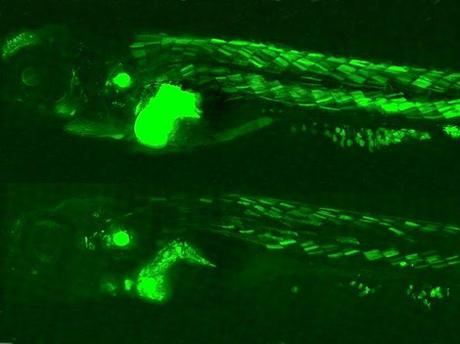A genetically engineered fish that glows green from the inside out is helping illuminate what pollutants do inside the body.

Zebrafish glow green under the microscope!!!
Endocrine disruptors are substances found in a wide range of industrial products, including plastics, as well as in many female contraceptives.
The chemicals mimic the actions of sexual hormones, resulting in various reproductive problems in both people and animals. Previous research has shown the chemicals that cause the fish to change gender and in people, endocrine disruptors have been associated with lower sperm counts and breast and testicular cancers.
Yet scientists have had difficulty tracking what endocrine disruptors do inside a person or an animal’s body. So a team genetically engineered zebrafish to glow in places where an endocrine-disrupting chemical is present—and thus show where it may be harming the body.
“We’ve essentially put genetic elements within the fish [embryos that], over time, that are specifically designed to identify where the chemicals penetrate and act within the body,” said study leader Charles Tylerat the U.K.’s University of Exeter.
“This genetic machinery produces proteins which don’t interfere with the way these chemicals act in the body, but they fluoresce green under a fluorescent microscope, providing a reporting system to identify which body tissues are being affected.
“This, in turn provides a more ‘intelligent’ way of identifying where the [pollutants'] potential health impacts might be” in people.
Glowing Fish Confirm Past Findings
Tyler and team exposed the zebrafish to varying levels of chemicals known to affect the hormone estrogen, including ethinyloestradiol, found in contraceptive pills; nonylphenol, present in paints and industrial detergents; and bisphenol A, a component of many plastics.
All of these substances have become common freshwater pollutants that are connected to problems such as gender changes in fish and decreased fertility and increased cases of cancer in people.
The researchers exposed the fish to different endrocrine disruptors at varying concentrations, and then used a microscope to see which of the small fish’s organs glowed—and thus responded—to the chemicals.
The data should help identify the thresholds at which the chemicals affect various tissues and organs in the body.
For instance, observing the glowing fish confirmed previous findings, such as a link between bisphenol A and heartproblems.
“We do see in this fish that the heart glows particularly in response to bisphenol A,” Tyler said. “So we can target the heart and try to look at the mechanics of what is happening.”
Tyler and colleagues also watched the chemicals light up other parts of the fish’s anatomy, including its eyes and skeletal muscles. Endocrine disruptors’ impacts to these parts of the body are unknown.
“It’s often been assumed that these chemicals impact the liver or testes or ovaries, but in these fish we’ve identified them in many different tissues, including parts of the brain,” he said.
For now, the fluorescent technology is limited to fish younger than six days old, because their skin has yet to develop pigmentation that would interfere with observing the fluorescence.
“The next phase is breeding these fish with a strain that lacks pigment in the skin,” which would allow the team to observe the fluorescent reactions in adult fish as well, Tyler said.
Courtesy-National Geographic

